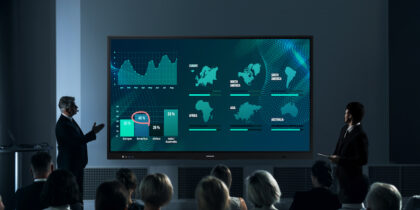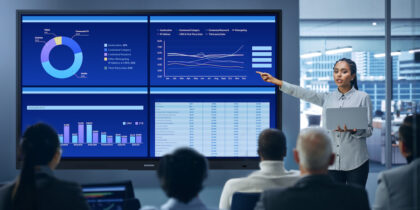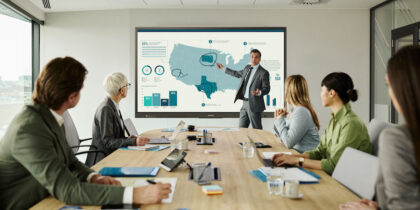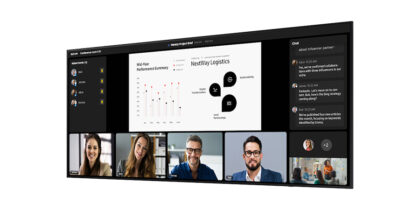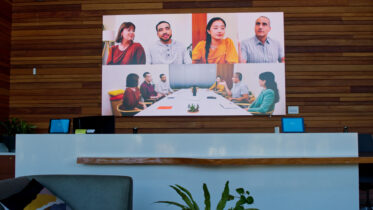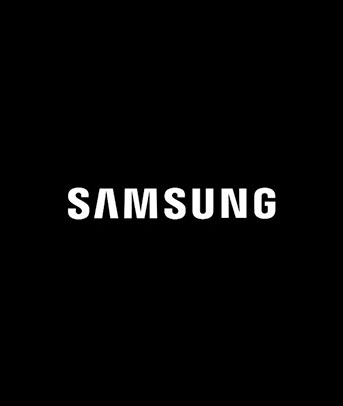Group meetings require group communication tools for success. Unfortunately, typical meetings today are disjointed and individual. Some people furiously scribble notes, while others jump up to capture whiteboard notes with their smartphone cameras. Still, others may not even be in the room but are following remotely.
It’s not just the attendees who have issues. Even presenters may struggle to connect their devices, software and file types to the technology in the room. All of this can fracture group focus and hamper collaboration.
The good news is that technology has come to the rescue again. Interactive displays and smart boards have not only consigned the old whiteboards and projectors to the dustbin of history, but they’ve grown to incorporate a tremendous suite of collaboration tools for businesses that are designed to facilitate group work and support successful outcomes.
How to plan and deploy direct view LED signage
Everything you need to know about choosing your LED displays for optimal viewing indoors and out. Download Now
The new Samsung WAF Interactive Display Series features the best collaboration tools available today, elevating the meeting space in seven important ways.
A digital workspace: 7 ways Samsung WAF Interactive Displays change everything
The Samsung WAF Interactive Display is changing how digital collaboration happens in the workplace. Here are seven ways they’re transforming the meeting room:
- Brainstorming: Presenters can jot down or draw a steady stream of ideas on the Samsung WAF Interactive Display. A friendly user interface allows users to switch colors and input types — from a thin pen to a thick brush — and erase with a simple swipe of their finger or palm. In fact, a dual-sided digital pen allows users to effortlessly switch between two different colors from the front and back sides of the pen without having to change settings or interrupt the meeting’s flow. In addition, old notes from past meetings can be retrieved for review and editing.
- Presenting: While you can use the Samsung WAF Interactive Display as a whiteboard, it can do much more for your presentations. The digital display can run through a presentation deck, image galleries and files, show websites and play video in up to 4K resolution. Presenters can split the screen into two windows and share content from multiple applications simultaneously. A similar feature, Split Note Mode, enables the screen to be split into sections, allowing four presenters to write or draw at the same time. They can also annotate — meaning they can write notes or draw on — the displayed content. Integrated videoconferencing extends the presentation to remote participants, too. The WAF Series comes with an AI Assistant tool, which provides voice transcription at the tap of an on-screen button, allowing you to capture and transcribe entire presentations, including notes and questions. You can also use the Circle to Search with Google tool for quick word and image searches directly on the display.
Furthermore, to allow staff to make presentations more seamlessly, new quick access controls on the front of the display give presenters fast access to frequently used functions. That way, they can operate the display fast and efficiently and not fumble with technology while speaking.
- Sharing: Up to nine in-person or remote employees can wirelessly connect their computers or smartphones and simultaneously share their screens on the Samsung WAF Interactive Display. The screen mirroring feature supports Mac, Windows, iOS, Android and Chrome OS devices. Meeting participants can also share files by connecting their devices to the display through USB-C and HDMI ports. So, instead of everyone huddling around a small computer or smartphone screen at the conference room table, you can simply push content to the WAF display so everyone can see more comfortably.
- Illustrating: With up to 40 simultaneous touchpoints on the WAF’s touchscreen display, multiple employees can write or draw simultaneously, using Samsung’s dual pen or even their fingers as a stylus. The WAF Interactive Display lets you draw in multiple pen colors, styles and thicknesses and insert 3D shapes like squares or circles.
- Personalizing: Because the Samsung WAF Interactive Display is based on the Android OS, the device operates familiarly and intuitively. It gives users access to widgets and applications, including the Google Workspace productivity suite and YouTube. Through Google Play, users can download any Android apps that they need. Businesses can also turn their WAF display into a Windows device by plugging a Windows PC device into the OPS (Open Pluggable Specification) slot on the display. That way, users will have access to all the features of a Windows-based computer directly on the display.
- Editing and appending: You can seamlessly connect the Samsung WAF Interactive Display to third-party apps like Microsoft 365 to edit and annotate anything — from layouts and proposals to images and schematics. Once done, they can capture and store the content, which leads to the last benefit.
- Saving, storing and distributing: Critical content from meetings, such as conversations or illustrations from brainstorming sessions, can be saved easily to the WAF Interactive Display’s 64GB built-in storage or uploaded to cloud storage. Samsung WAF’s AI Assistant tool also allows you to create an instant summary of the presentation, automatically populating headers for each section and timestamps where certain points were made. Presenters can share the content by emailing meeting attendees or making it available in the cloud.
Collaborate with Samsung WAF Interactive Displays
Samsung WAF Interactive Displays come in three form factors — 65-inch, 75-inch and 86-inch — that combine the benefits of easel-based paper flip charts, traditional whiteboards and room projectors into one. The result is a super-charged digital collaboration tool for everyone. Furthermore, the user experience is intuitive, too, so initial training takes mere minutes, and meeting setup is minimal. Most users can walk up to the Samsung WAF Interactive Display for the first time and immediately get to work.
That work will become all the more dynamic and effective thanks to the collaboration technology and software packed inside, whether at the ideation stage of a project or the final presentation. The display unifies the room, putting all technology under one umbrella, aligning platforms and streamlining connections. Samsung WAF Interactive Display also embraces today’s hybrid and remote work world by incorporating powerful videoconferencing technology, ensuring more people have a voice at the table.
Workplace versatility
Business success today often depends on versatility — and that takes in technology, too. Samsung WAF Interactive Displays provide that flexibility in the workplace with an impressive set of digital collaboration tools that help transform ideas into reality. Meetings that start as simple discussions become more interactive, lively and productive — just by someone standing up, walking over to the display and getting to work.
Learn more about incorporating smart conference room technology with this free guide. And discover how digital displays can also lead to cost savings at the office.

